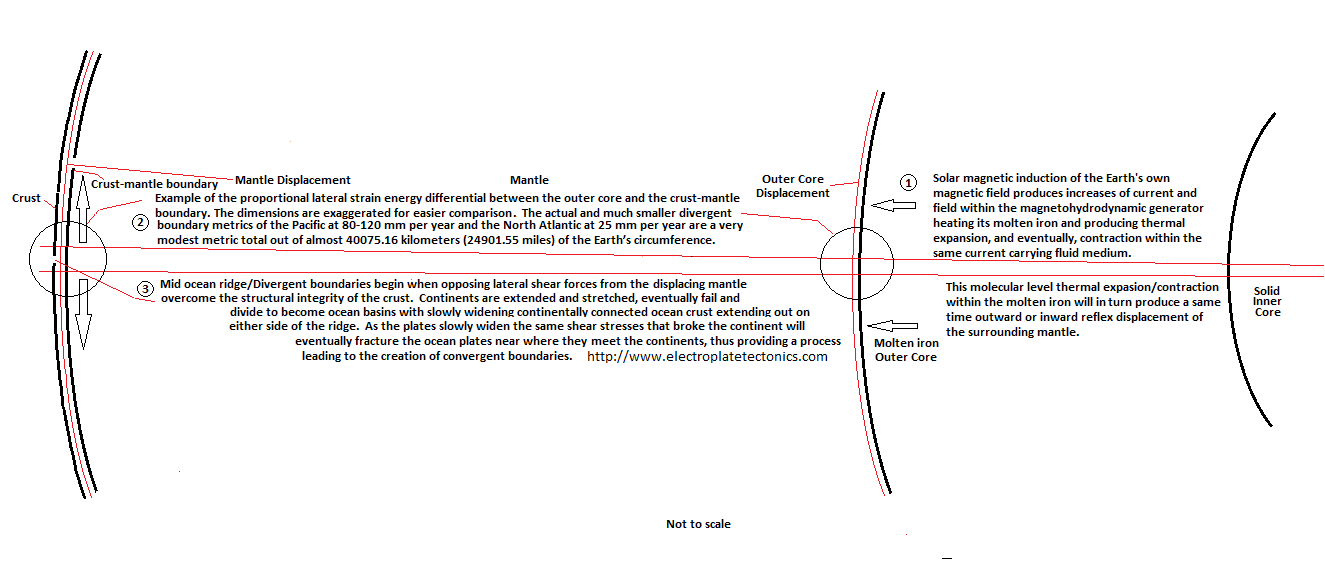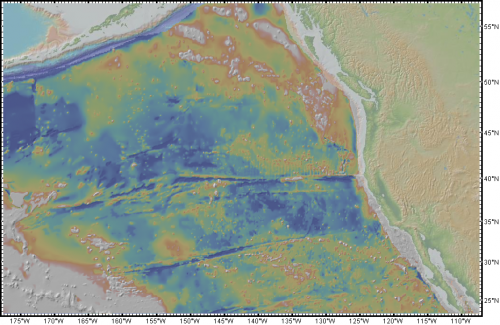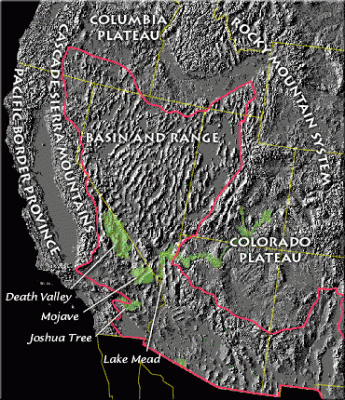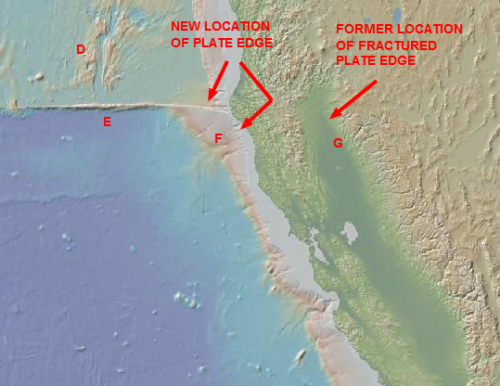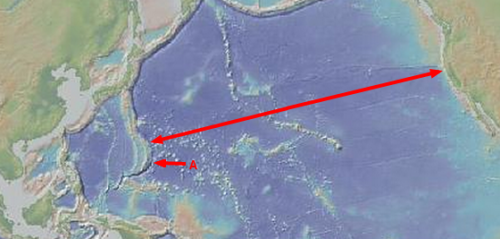-
Posts
978 -
Joined
-
Last visited
Content Type
Profiles
Forums
Events
Everything posted by arc
-

magnetic changes in earthfield related to volcanic hotspot
arc replied to martinblochnielsen22's topic in Earth Science
About that spellchecker, it doesn't distinguish between mantle and mantel. For the thousandth time! -
I forgot to credit that image above. Image above used and modified by this author was furnished through and in no way endorsed by://www.geomapapp.org using Global Multi-Resolution Topography (GMRT) Synthesis, Ryan, W. B. F., S.M. Carbotte, J. Coplan, S. O'Hara, A. Melkonian, R. Arko, R.A. Weissel, V. Ferrini, A. Goodwillie, F. Nitsche, J. Bonczkowski, and R. Zemsky (2009), Global Multi-Resolution Topography (GMRT) synthesis data set, Geochem. Geophys. Geosyst., 10, Q03014, doi:10.1029/2008GC002332. Data doi: 10.1594/IEDA.0001000, through http://creativecommons.org/licenses/by-nc-sa/3.0/us/ I would recommend to anyone who hasn't tried geomapapp to check it out. It is really fun. Though I wish the seafloor images at closer range had as high of resolution as Google Earth. I'm going to show another geomapapp image of the same area. I think it tells a story of the Earth's surface in a unique way. That same section of seafloor mentioned above is now seen in this incredible thermal image. You can clearly see the Mendocino Fracture Zone on it's northern edge and the Murray fracture Zone on the southern. The blue cooler areas of the section contrast to those to the north and south. Why is this section cooler? The reason is it is older than the others to the north and south. The image below is a USGS seafloor age map. That black line along the coast above the Baja Peninsula is the San Andreas Fault that runs N.W. and intersects the Mendocino Fault. The darkest red indicates most recent age. As you can see its lagging behind the northern and southern sections by maybe a 1000 km and 15-20 million years. I wish these images had better resolution when enlarged. Now referring back to that geoapp. The story that I see in these images is told by that big green depression just east of the San Andreas Fault, it's known as the Central Valley and it has an interesting alignment to the Mendocino and Murray Fault lines. Just beyond the valley is the Sierra Nevada Mountains and on past farther east is the Basin and Range extension. So we already according to the model have the Basin and Range pulled out to the west by the tension in the plate section due to the thermal cycles slow expansion of the crust, causing the retraction of the overran Pacific Plate. It looks to me that the plate section broke from the massive tension at the east side of the Central Valley. As the plate was slowly pulled west the overriding continental crust filled in the slowly developing void. In this closer detail above one can see the Mendocino misalignment clearly. The ocean plate south of the fracture zone (E) has what appears to be a defined offset. The area forming the radius at (F) looks to have been retracted out from under the sunken Central Valley. The Juan de Fuca fracture (D) was probably a tear caused by the catastrophic plate failure. The Mendocino Fracture Zone (E) failed under the sudden release as did the Murray Fracture to the south. Image courtesy of USGS The Basin and range is a unique feature on the Earth. I believe it is actually the same type of planation that preceded the creation of the North American Cordillera (Rocky Mountains) just to it's east. The broken and decoupled plate will not stop the eventual compression of the thermal cycle that in millions of years from now will take this spread out assemblage of ranges and valleys and slowly over millions more bulldoze it into a pile of tilted rock and debris that will then require maybe 50 million years more to erode to resemble the current American Cordillera.
-
(Image credited to Ryan, W. B. F., S.M. Carbotte, J. Coplan, S. O'Hara, A. Melkonian, R. Arko, R.A. Weissel, V. Ferrini, A. Goodwillie, F. Nitsche, J. Bonczkowski, and R. Zemsky (2009), Global Multi-Resolution Topography (GMRT) synthesis data set, Geochem. Geophys. Geosyst., 10, Q03014, doi:10.1029/2008GC002332. Data doi: 10.1594/IEDA.0001000, through http://creativecommo...y-nc-sa/3.0/us/ ) Well, I think I'll discuss some of the evidence of the crust being put under extreme tension for millions of years. In the S.W. United States there is the Basin and Range area, the lateral displacement varies between 60 to 300 km since the beginning of the extension in the early Miocene. The Miocene Epoch was 23.03 to 5.3 million years ago. Currently there is no clear and concise explanation for this event. The particular latitudinal section of sea floor that was subducted or overran by this area extends all the way to the Mariana Trench (A) in the western Pacific. Interesting isn't it. The deepest trench in the world is on one end and the largest example of extensional processes is on the other. The eastern side of this section of sea floor has defined fault slip edges referred to as the Mendocino Fracture Zone in the north and the Murray Fracture Zone in the south. The model has the Pacific Plate over ran and held by the North American continent due to a long period of contraction from the previously mentioned mechanism. As the cycle changes to thermal expansion the plate was loaded with slowly increasing tension from the plates inability to move through mechanisms such as a divergent plate boundary. The subduction under the N. American continent eliminated all or most of that tension release mechanism. The Basin and Range was pulled instead, possibly through several thermal cycles, while the Mariana Trench was pulled eastward. This is clearly observed in the image above.
-
Very good points. I hope you had time to read my work. I think the entire plate matrix has a uneven distribution of compression which causes the observed subduction in some trenches while others have less, Aleutian for example, while others have what appears to be none. I believe there is currently not any observed subduction in the Mediterranean which my model answers. But I stray. The reason there is varying amounts of subduction is due to the large difference in the plate sizes and masses. The model provides a means to preload the entire plate matrix simultaneously. Lets imagine that there is a small current/temperature variable over millions of years in the Earth's magnetohydrodynamic field generator ( that could and probably would also be expected in the current standard model I think) and it slowly raises the outer core's temperature a fraction of a degree over those millions of years. A fraction of a degree over millions of years. I believe almost everyone would expect the liquid outer core to thermally expand a proportionate amount to the degree of temperature rise. Now what would you expect from the mantle? Do you think it could contain the molecular level expansion forces of the core's liquid iron? The mantle is under extremely high pressures and temperatures especially the deeper you go. Would you think that it would move out a little making a little more room in its interior? Unlikely, I think in ether model most would expect the mantel would show a reflex at its outer boundary. But how much? I would think it would resemble the current seafloor spreading metrics. So lets say this continues over a couple of million years building up a nice little slice of new divergent plate infill in the worlds entire divergent inventory. Now we start into that lower level part of the cycle with the core going down a fraction of a degree over millions of years. As the liquid iron lowers imperceptibly the mantle responds and moves in tandem. What will the crust do? It would likely move with the mantel but it can't because of the nice new slice of seafloor that now blocks its pathway down. The plates begin to preload like a Roman arch, slowly sliding to the opposite direction into the trench. Something neat is happening here tho, the plates all have different masses, from some of the largest like the Pacific or say Eurasia to the smaller down to the micro plates. The larger plates take the longest amount of time to unload while the smaller may be able to even slip some on the edges to release even faster. Refering to this claim; Plate tectonicists insist that the volume of crust generated at midocean ridges is equaled by the volume subducted. But whereas 80,000 km of midocean ridges are supposedly producing new crust, only 30,500 km of trenches exist. Even if we add the 9000 km of "collision zones," the figure is still only half that of the "spreading centers" (Smoot, 1997a). In my model this would indicate that the subduction lags behind the expansion portion of the cycle. It takes longer for the plates to melt into the asthenosphere than it does to create the infill that leverages the plate into the trench. So the answer to why is there some subduction happening now?, would be because not all of the plate compression (probably the largest ones) has bled out into the trenches before this current expansion cycle started. The outer core thermal cycle is variable throughout its cycle, even from one maximum to the next in both timing and duration. Now lets say we have a extra long thermal expansion cycle and the divergent plate boundaries build up a very large infill, one of those that only happens every 20 or 30 million years. When the outer core begins to cool and initiates the plates subduction the trenches will be, like before, slower to receive the plate material than the mantles withdraw. The compression begins building on the plates, being only able to over come the trenches rates of resistances to a point. As the mantle continues down the plates are subjected to loads that require vertical movement of rock strata to relieve to massive compression building on the plates, this compression is in proportion to the length of time and degree of expansion in the previous cycle in relation to the degree of cooling in this cycle. I can only suggest this would work under the current standard model but I am aware that Gerard C. Bond noted that "when the Sun is at its most energetic, the Earths field is strengthened" http://www.ncdc.noaa.gov/paleo/ctl/clisci10kb.html This suggests to me that there is some mutual inductive coupling between the Sun's field and Earth's. Similar to the approximate 2 terrawatts of power that is generated between the surface of Jupiter and its moon Io by a similar dynamo mechanism. Image courtesy of NASA Or the other examples of mutual inductive coupling in the solar system http://www.igpp.ucla.edu/people/mkivelson/Publications/ICRUS1572507.pdf Magnetometer data from Galileo’s multiple flybys of Ganymede provide significant, but not unambiguous, evidence that the moon, like its neighboring satellites Europa and Callisto, responds inductively to Jupiter’s time-varying magnetic field. The Earth has approximately around 22 terra watts of unaccounted internal thermal flux, I would suggest that this could be the current level of induction. You have me at a disadvantage, I do not possess the math skill you require. But my pen is as sharp as my will is strong, so lets continue. Let me throw in a few extras to move things along, you can actually examine the Earth's thermal cycles by going to goggle maps and look at the Hawaiian Island chain and its undersea ancestors of the Emperor Seamount Chain that are maybe the best record of these cycles. You can see how long the individual expansion cycles were by the size of the Island that was built, then when the core cooled the plate slide into the trench and repositioned the plate over the hot spot where the next island could began, as this was the start of the next thermal increase and expansion. The distance between the individual islands and the sea mounts is indicative how long the cooling cycles were at each. This is all explained in detail on my site. Thank you, I hope this was enough detail for your answers.
-
Sorry Mike didn't mean to wreak your groove. I'm a writer with Asperger's, I get a little carried away. Remind you of somebody else around here ? I'll stick to my own post's so we don't have anymore runaway keyboard accidents.
-
I think I hit onto a really nice fit for plate tectonics. The Earth's core is an electro - magnetic field generator. I could not imagine that it wouldn't have variability in it's cycling of current and field. Nothing is going to be constant, especially magnitohydrodynamic generation as it cycles current and field. I thought the Sun's magnetic field could be imposing variation over longer time periods giving the Earth a historic variable thermal cycle to move the tectonic plates. So I started with a simple model, just a divergent plate boundary, a plate and a convergent boundary (trench). The cycle begins with a small thermal increase in the molten iron core from increased current due to induction from the strengthening of the Sun's magnetic field. As the molten core presses out from thermal expansion it expands the mantle ever so slightly which opens the divergent plate boundaries in the currently observed manner, filling with magma as they expand. After several million years of this solar increase induced cycle the Sun's magnetic field lowers and the Earth's field generator's core begins a cooler period of operation. As the core and mantle slowly recede the crust is put into compression against the newest divergent boundary deposits which leverages the crust towards the trench as the crust follows the mantle as it recedes from the cooling core. This is when the subduction takes place. The compression bleeds into the trenches until the next heat cycle increase. I have written a complete comprehensive version of this you can view by going to my profile page. This shows how the island arcs are formed, the Mariana Trench, mountain ranges and the basin and range area of S.W. United States and lots more. It is a match for every geologic mystery that I have applied it to. We can do the question and answer thing but its going to take a long time because I have a lot of accurate observations.
-
Thank you Mike, I appreciate the encouragement. Back when I was a teen I worked on this problem a little. The great Carl Sagan in his Cosmos series stated that but not for a few fundamental discoveries during an age of discovery that led to an industrial revolution of their own and as they say the rest of the story, the Greeks (ancient) could have been first to land on the moon. When I was younger I wanted to be an inventor and made some observations of the processes involved that led me to some concepts that I think fit into this discussion. I never liked the term inventor, it suggests to me and maybe others that new idea's appear out of nowhere, having no existence until its formation in the inventors mind. But in reality everything we now view as "our" science and technology could have been discovered by the Greeks. And this reality in turn would apply to them. The act of invention or more accurately the act of discovery is the reveling of what was hidden, the uncovering of what has always been here unseen since the beginning of the Universe and maybe before. This physical Universe that we struggle to define in numerical order is viewed by some at its basic descriptive element as information in a numerical format. But the physical Universe is I believe only a part of what is here around us. Your premise that "Anything or everything can occur, if there is no reason for it not to occur" is akin to the knowledge that at anytime since at least the Big Bang any discovery of an idea that has been made or ever will by an intelligent being anywhere in the Cosmos has been there, indifferent to our existence or our ability to surmise its value or its existence. This is a measurable content. What is the monetary value of every discovery of mankind. What is the value of everything we haven't discovered yet or sadly never will, the ideas that are forever beyond our reach, discovered long ago, currently and in the future by civilizations greater than ours. This knowledge we covet as our civilizations greatest achievements is as close to receiving something from another dimension as mankind may possibly ever experience. We are predisposed to think that every idea is like the object that it will likely become, a place where it was acquired; The place where it was abandoned. The idea, the discovery is in the same place it has been always, which is everywhere. Every idea (which is innumerably) occupies every place, which is what aligns this post to your mold and your idea of "many possible paths" and "not too bothered where you (figuratively) came from, other than that you (figuratively) arrived". We are ourselves of the same ethereal library of all things possible, even every possible manifestation in the tree of evolution is there. This idea that we find ourselves discussing came to us both at different times and places and its source remains where it has been always and may exist far beyond the lifetime of this possibly mortal Universe. I believe I heard Steven Hawking say "once information is created it cannot be destroyed". I have to respectively disagree with him on this one because it may not be created in this paradigm but only discovered by those driven to learn.
-
This is my first post. I personally visualize the world in 3-D color process, not in complex mathematical equations. People first imagine a new building as an architectural concept with a given degree of aesthetic design, where the visual (and in this lingual) is given precedent over the numerical. It will go through many revisions as it transitions to those skilled in the numerical “arts” of calculating the loads and limits, maximums and minimums of the structural, mechanical and electrical systems that are in their own paradigm the actual real world being used in this application to support and make possible the aesthetic and sometimes illusionary tricks of dimensional space and architecture. Einstein imagined his famous thought experiments that were abstract architectural concepts of the universe. Abstract because in them he was for example, traveling towards the speed of light on or adjacent to a light beam. He was then able to work out the equations for his observations made from an abstract reality. There are some, who build from the structural direction, letting the numerical decide where to draw the boundaries that often lead to structures that are by the simplest term ugly but robust, able to withstand great amounts of stresses. Others, often referred to as crackpots, build only in abstract architectural concepts that crumble as the design is moved to a numerical reality.

